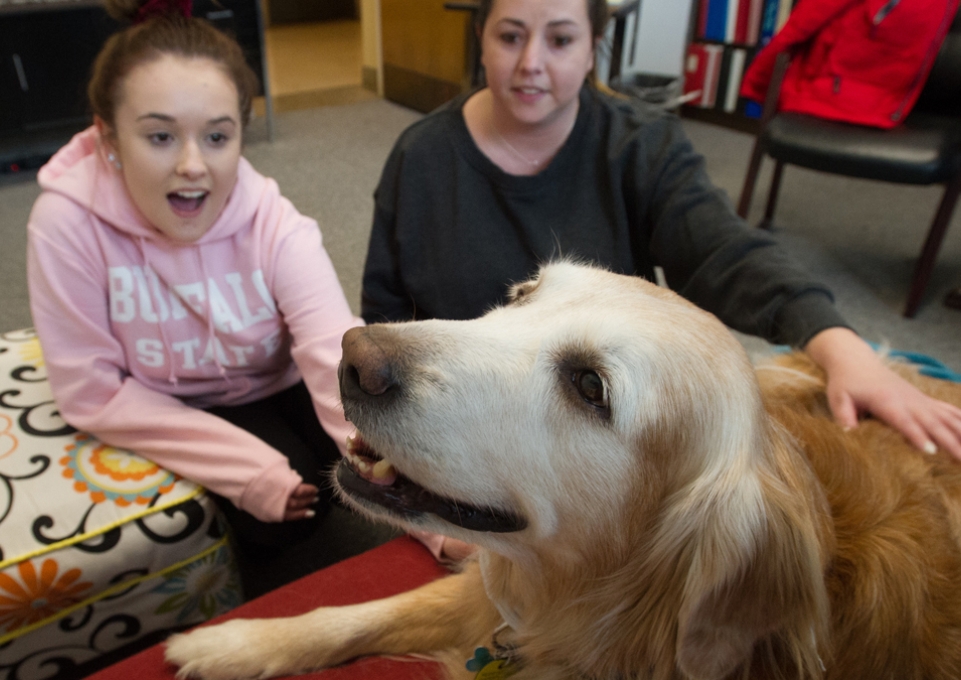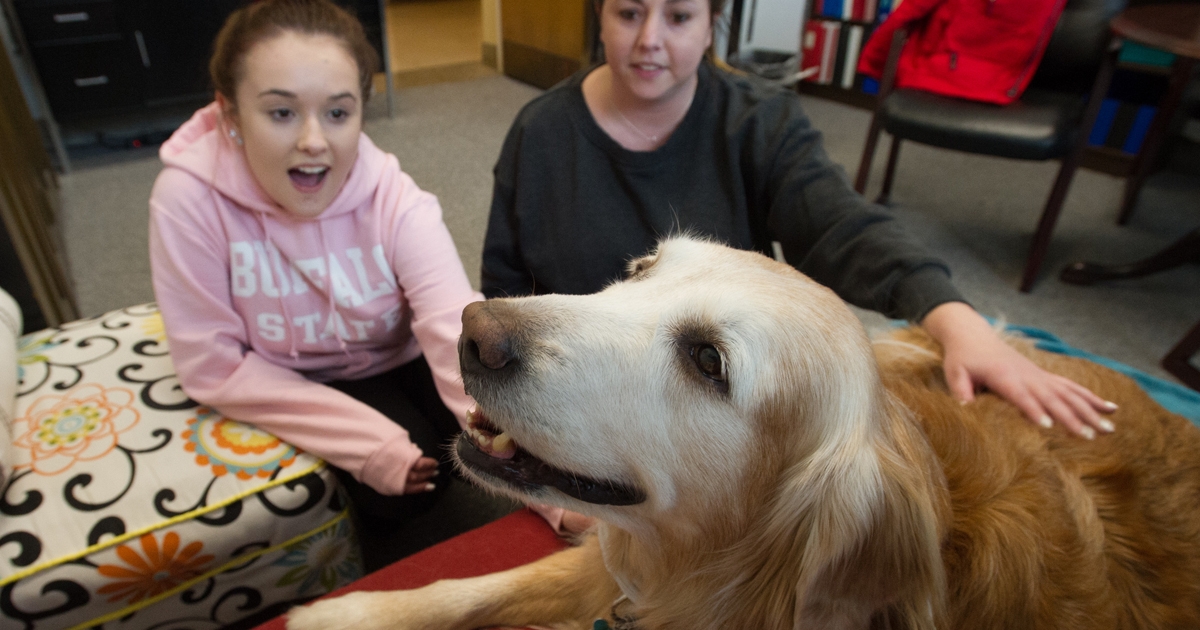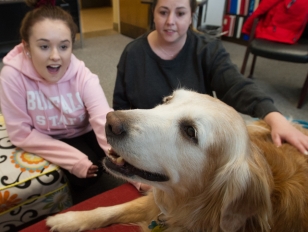
The history of animal-assisted therapy dates back to the ancient Greeks, who used horses to uplift the spirits of the ill. The first formal research into the practice began in the 1960s and revolved around the positive impact dogs had on younger developmentally disabled patients. While controversial at the time because of societal attitudes toward animals, animal-assisted therapy is now widely considered a part of modern-day therapeutic practices.
At Buffalo State College, Stella the Amazing Therapy Dog, a 9-year-old golden retriever owned by associate professor of exceptional education Krista Vince Garland, provides both companionship and therapy for children, college students, adults, and the elderly.
“She’s a rock star,” Vince Garland said of Stella. “She works so well with everyone.”
Buffalo State students can find Stella with Vince Garland during her office hours every Thursday from 2:00 to 4:00 p.m. in Ketchum Hall 216. All students are welcome to visit with her. She’s usually sitting near the open door of Vince Garland’s office, a welcoming beacon to students walking by.
She also works with adults going through addiction treatment at Evergreen Health Services and seniors at Beechwood Continuing Care.
Stella interacts with students at several public elementary schools in Buffalo during the district’s Saturday Academies, where she sits with students while they read, providing a comfortable environment to help them master their skills. She also works with students at Hamlin Park Elementary School, providing a calming influence.
“She’s also used as a reinforcer of good behavior,” Vince Garland said. “Kids can earn time hanging out with her. Children in classrooms who are caught doing something good will get a visit from her.”
While therapy dogs are sometimes confused with service dogs, there are major differences between the two. Service dogs are trained to help their handlers with a specific disability, such as blindness, or a mental health issue, such as anxiety. Service dogs should not be approached, as they are working when they’re out in the community, and their owners usually have a no-petting policy.
Therapy dogs, on the other hand, are meant to provide psychological or physiological comfort to people aside from their owners. They’re encouraged to interact with others while working. Therapy dogs work in schools, hospitals, and nursing and hospice facilities among other places, and petting is strongly encouraged. Like service dogs, therapy dogs must meet certain standards in order to be certified. These standards include being good-natured, completing testing by a certified observer for handling and demeanor, and undergoing supervised visits to a facility with the observer.
Stella is an American Kennel Club Good Citizen and has received initial evaluation via Therapy Dogs International. She also holds certificates through the Erie County SPCA’s Paws for Love program, which provides liability insurance.
Some of the elementary school students Stella works with haven’t had good experiences with dogs, Vince Garland said, and Stella provides a chance for them to get to know a friendly dog. Those students often start by brushing Stella, before moving on to petting her with their hand.
“With some of the less-than-stellar experiences that the kids have been through, they’ll be nervous to work with her,” Vince Garland said. “So we do things for different groups. Sometimes she wears silly headbands for the elementary school kids. She actually kind of likes it.”
Vince Garland will soon be introducing two new dogs to students—Lemon, a 4-year-old golden retriever, and Goose, a 5-month-old dalmatian.
Wendy Paterson, dean of the School of Education, said she’s excited to see what kind of impact Stella and her fur-siblings will have on students at Buffalo State and in the community going forward.
“Krista has embarked on a new scholarly service effort that will bring our exceptional education candidates new and wonderfully unique experiences. Trained therapy animals are showing great promise in research on traumatic brain injuries, PTSD [post-traumatic stress disorder], autism, and other severe disabilities,” Paterson said. “This is to say nothing about creating acres of smiles among all the children, parents, and elderly clients Stella visits.”
Paterson has had her own experiences with Stella, who visits her mother in a long-term care facility. At 98, Paterson’s mother has lost much of her mobility and has progressive dementia. The visits help.
“The amazing Stella and her equally amazing human mom, Krista, have visited my mom often, bringing joy, warmth, and love to her as they do in all the places they visit where those qualities are in short supply,” she said. “The School of Education is very proud to support such an innovative program that addresses the needs of humans across the lifespan. After all, isn’t that the mission of education?”
Photos by Bruce Fox, campus photographer.



